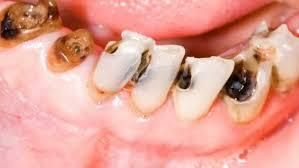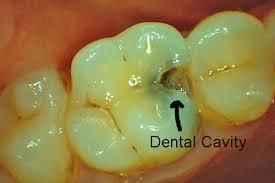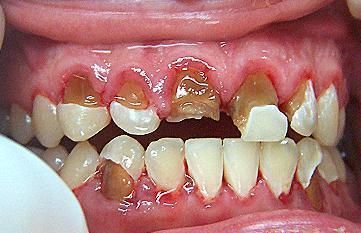Tooth decay is a multifactorial, multiple-pathogen biofilm disease process that occurs when tooth enamel, one of the hardest highly mineralized compounds in the human body, is weakened by acid and becomes dissolved. This can occur easily as certain types of mouth bacteria process the sugars that are left in the mouth from foods and drinks. The sugars that are the easiest for mouth bacteria to break down are simple sugars and starches; the immediate result from the bacterial utilization of these sugars is an increase in the numbers of both acid loving (aciduric) bacteria and acid producing (acidogenic) bacteria – ultimately leading to an increase in acid formation. Excessive amounts and frequent consumption of sugars and acidic foods and beverages can cause a prolonged, intense, low pH in the mouth resulting in the death of healthy bacteria and overgrowth of cavity-causing bacteria. Acid begins to erode the enamel surface at a pH of 5.5. As minerals leave the tooth, the enamel continues to weaken until a hole or cavity is formed leading into the deeper layers of the tooth; this process is also known as dental caries. As a patient increases the frequency of exposure to food and drink, they are increasing the number of acid attacks their teeth experience. The more acid attacks that occur, the more likely the patient’s biofilm will change from normal healthy bacteria to cavity-causing bacteria, and their teeth will experience demineralization during the acid attacks. This imbalance occurs based on each individual’s oral environment, dietary habits, and hygiene habits. Populations with inadequate exposure to fluorides are at additional risk. Left untreated, tooth decay can cause considerable pain, tooth loss, widespread infection, and school and work absenteeism.
There are other factors that can contribute to enamel breakdown: low saliva, and ingestion of acidic foods and beverages, acid reflux. Saliva normally has a protective effect upon enamel; it serves to buffer and neutralize acids; inadequate saliva production because of age, disease, or medication, can lead to an increase in the acidity of the oral environment and further destruction of enamel. Foods and beverages that are already acidic, like soda, coffee, tea, or some fruits and juices, also dissolve enamel, as does regurgitation of stomach acids into the mouth from acid reflux diseases. Dietary habits are as significant in the development of tooth decay as they are in the development of chronic diseases.



STATISTICS:
Worldwide, the prevalence of dental caries among adults is high as the disease affects nearly 100% of the population in the majority of countries. Dental caries is still a major health problem in most industrialized countries affecting 60–90% of school-aged children, making it the number one most prevalent disease of childhood. As part of the recent international collaborative Global Burden of Disease Study, untreated tooth decay was identified as the most common condition among 291 diseases studied. It remains the most common chronic disease of children aged 5 to 17 years—4 times more common than asthma (42% versus 9.5%). According to the Centers for Disease Control and Prevention, although largely preventable, dental caries is an epidemic in the United States (16% of children aged 6–19 years have untreated dental caries; 23% of adults aged 20–64 years have untreated dental caries).
PREVENTION:
- Remove bacteria and sugar sources from the tooth surface by improving oral hygiene routines. This can be accomplished by effective and thorough brushing at least twice daily with a fluoride toothpaste, and flossing between teeth once daily where toothbrush bristles can’t reach.
- Reduce or remove sugar and acidic foods and drinks from the diet. Consume whole foods and eliminate processed foods. Avoid sugary beverages such as sodas, Kool-Aid, sports and energy drinks, and reconstituted fruit juices; soda, tea, coffee, wine, flavored waters, and juices are all acidic, even if they do not contain sugar. Avoid regular consumption of sticky sugars and starches like suckers, candy, sugar chewing gum, cough drops, breath mints, caramel, fruit chews, crackers, and cookies. Avoid in-between-meal snacking and drinking acidic beverages. Frequency of consumption is important. Each time a food or beverage is consumed, it should be as part of a meal; each in-between-meal snack or beverage results in a new acid attack. Rinse with water immediately after consumption of acidic or acid producing food or drinks; brush one half hour later, drink acidic drinks thru a straw.
- Improve the strength of tooth enamel. Fluoride helps prevent tooth enamel from being dissolved by acids. Fluoride can be incorporated into the structure of teeth from consuming optimum levels of fluoridated drinking water especially from age 6 months to age 8, when teeth are still developing. Most national and international organizations, such as the United States Public Health Service, the American Academy of Pediatrics, the American Dental Association, the World Health Organization, and the CDC among others, endorse community water fluoridation. If your drinking water does not come from a public source, consult your pediatrician or dentist. Well water may need to be tested for optimum levels of naturally occurring fluorides, if any; if no fluoride is detected in the water, fluoride vitamin supplements may be suggested for children. If the source of drinking water is from bottled sources, look for water labeled with added fluoride. After teeth have erupted, topical application of fluoride to the enamel from fluoride toothpaste and professional dental applications can re-mineralize and strengthen the surface of the tooth; this will aid in preventing new cavities from forming and slow or reverse the beginning stages of tooth decay.
- Maintain professional dental care. Your dentist can detect tooth decay in its earliest stages. Early care means repair of a tooth with a cavity is simpler, quicker, less costly, conservative, and more comfortable when the decay is just starting. Prevention is key. Professionally applied fluoride treatments, extra strength prescription fluoride toothpaste, and rinses are preventive measures designed to strengthen enamel. Once decay has started, your dentist can remove the decay and restore the tooth back to functional form by repairing the hole with filling material; otherwise, tooth decay can proceed through the body of the tooth until the nerves in the tooth become infected. Another preventive measure, sealants, a paint-on protective coating for the chewing surfaces of back teeth before a cavity forms, can be applied to deep pits and grooves that are most prone to decay. Dental experts can further assist you on ways to be the most effective with brushing and flossing, as well as, help provide guidance on proper nutrition. Your dentist may also evaluate the health conditions and medications that reduce saliva essay writing flow and prescribe saliva substitutes where necessary.
Resources:

